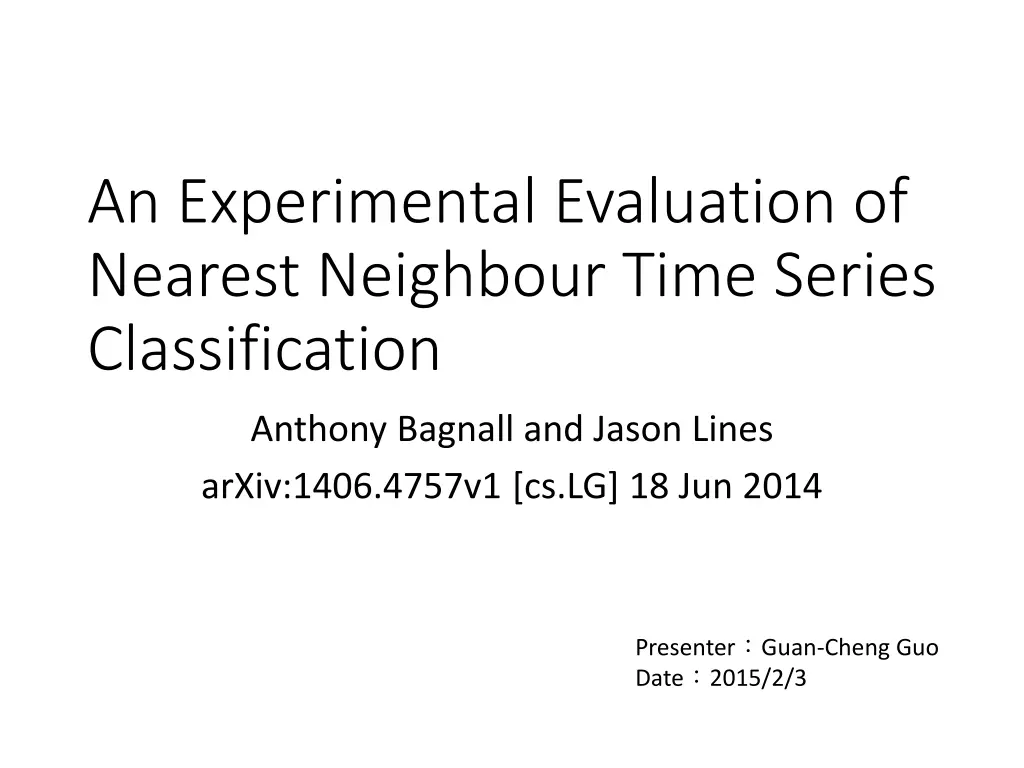
Nearest Neighbour Time Series Classification Evaluation
Explore the effectiveness of nearest neighbour classifiers using Euclidean and Dynamic Time Warping distances in time series classification, highlighting the importance of parameter settings for optimal performance.
Download Presentation

Please find below an Image/Link to download the presentation.
The content on the website is provided AS IS for your information and personal use only. It may not be sold, licensed, or shared on other websites without obtaining consent from the author. If you encounter any issues during the download, it is possible that the publisher has removed the file from their server.
You are allowed to download the files provided on this website for personal or commercial use, subject to the condition that they are used lawfully. All files are the property of their respective owners.
The content on the website is provided AS IS for your information and personal use only. It may not be sold, licensed, or shared on other websites without obtaining consent from the author.
E N D
Presentation Transcript
An Experimental Evaluation of Nearest Neighbour Time Series Classification Anthony Bagnall and Jason Lines arXiv:1406.4757v1 [cs.LG] 18 Jun 2014 Presenter Guan-Cheng Guo Date 2015/2/3
Abstract Data mining research into time series classification (TSC) has focussed on alternative distance measures for nearest neighbour classifiers. It is standard practice to use 1-NN with Euclidean or dynamic time warping (DTW) distance as a straw man for comparison. As part of a wider investigation into elastic distance measures for TSC, we perform a series of experiments to test whether this standard practice is valid.
Abstract Specifically, we compare 1-NN classifiers with Euclidean and DTW distance to standard classifiers, examine whether the performance of 1-NN Euclidean approaches that of 1-NN DTW as the number of cases increases, assess whether there is any benefit of setting k for k-NN through cross validation whether it is worth setting the warping path for DTW through cross validation and finally is it better to use a window or weighting for DTW. Based on experiments on 77 problems, we conclude that 1-NN with Euclidean distance is fairly easy to beat but 1-NN with DTW is not, if window size is set through cross validation.
Longest common Subsequence Distance (LCSS) A = (a1, a2...am) and B = (b1, b2...bm) 0 ????,?+ 1 max(????,? 1,???? 1,?) Longest common Subsequence distance threshold match threshold match ?????,?= 0 if i = 0 or j = 0 if ai= bi if ai bi ????, ?= if i = 0 or j = 0 ( ai bi)2 thr ( ai bi)2> thr ????? 1, ? 1+ 1 if max ?????, ? 1,????? 1, ? if
Dynamic Time Warping (DTW) ???? 1,? ????,? 1 ???? 1,? 1 ????,?= ?(??,??) + ??? ? is Euclidean distance
Warping Window DTW match path
Derivative Dynamic Time Warping (DDTW) ? ??,?? ? (??[??],??[??]) ?? ?? 1+(??+1 ?? 1 ) ???? = ???? ?? 2 2
Weighted Dynamic Time Warping (WDTW) ???? ??= wmaxis an upper bound on the weight (set to 1),m isthe series length and g is a parameter that controls the penaltylevel for large warpings. 1+exp( ?(? ?/2)) Distance matrixM M?,?= ?? ?(?? ??)2
Time Series Data Set Data sets grouped by problem type
Experimental Results Average ranks of 6 classifiers split by problem type. (1-NN Euclidean , 1-NN with DTW, Random Forest, rotation forest, linear support vector machine and quadratic support vector machine).
Is it worth setting k through cross validation? We are using 7 variants of distance measure with nearest neighbour classifiers: Euclidean (Euclid) DTW with full warping window (DTWR1) DTW with warping window set through cross validation (DTWRN) Derivative DTW with full and CV set warping windows (DDTWR1 and DDTWRN) weighted DTW and DDTW (WDTW and WDDTW)
Is it worth setting k through cross validation? Euclidean (Euclid), DTW with full warping window (DTWR1), DTW with warping window set through cross validation (DTWRN), Derivative DTW with full and CV set warping windows (DDTWR1 and DDTWRN) weighted DTW and DDTW (WDTW and WDDTW). Summary statistics on the difference in accuracy between 1-nn and k-nn classifiers. The final two columns give the p value for a paired two sample t test for difference in means and a Wilcoxon signed-rank test for difference in Medians.
Experimental Results LCSS performs well on the motion data and image, but ranks poorly on sensor. weighted and windowed DTW rank highly on motion and sensor but relatively poorly on image outlines. Average ranks of 6 1-nn elastic measure classifiers split by problem type.
Conclusions When using a NN classifier with DTW on a new problem, we would advise that it is not particularly important to set k through cross validation, but that setting the warping window size is worthwhile. Weighting algorithm for DTW described is significantly better than DTW with a full warping window, but not significantly different to DTW with the window set through cross validation.
